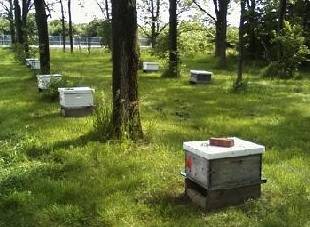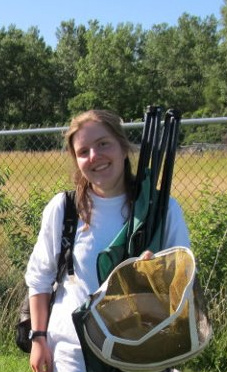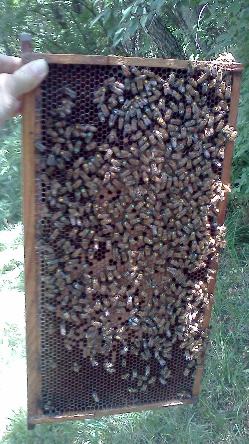I lift a frame of wax comb out of the colony and watch a young honey bee worker chewing her way out of a cell. As she finally emerges, I see a stark contrast between the older, balding bees, and this clumsy, fuzzy newcomer. I wonder: What sort of a worker will she turn into? Will she spend most of her career feeding young larvae? Will she guard the colony from robber bees? Will she carry dead comrades out of the hive? At the same time, I witness thousands of other workers do all of these tasks. They run or walk over the other frames without even noticing me. Inspecting a honey bee colony reminds me that, while a colony consists of individual worker bees, colony health and survival depends on the way they act as a group.
 Early this summer, a friend of mine asked me about starting a colony in his backyard. My friend, Chris Holmes, has lived in Urbana for 22 years and now studies ecology and evolution at the University of Illinois. As he says, “I have always known what a tremendous resource they were in terms of ecosystem functioning, pollinating, and thought it would be fun and beneficial to start a colony.” We bought a queen and three pounds of workers. We gave them a box with some empty frames in it, and then fed them sugar water each week for the first month. The rest, we left to them. In just three weeks they had built wax comb on most of the empty frames and filled half of them with honey! I felt so proud (as if I accomplished all this myself).
Early this summer, a friend of mine asked me about starting a colony in his backyard. My friend, Chris Holmes, has lived in Urbana for 22 years and now studies ecology and evolution at the University of Illinois. As he says, “I have always known what a tremendous resource they were in terms of ecosystem functioning, pollinating, and thought it would be fun and beneficial to start a colony.” We bought a queen and three pounds of workers. We gave them a box with some empty frames in it, and then fed them sugar water each week for the first month. The rest, we left to them. In just three weeks they had built wax comb on most of the empty frames and filled half of them with honey! I felt so proud (as if I accomplished all this myself).
I agree with Chris that keeping bees is “definitely a learning experience.” I started studying honey bee behavior three years ago, first in college, and now as a graduate student in Dr. Gene Robinson’s lab at the University of Illinois. I have worked with many colonies for my research, but this experience of caring for a colony just to watch it grow and develop has given me a new appreciation for these hard-working insects.
To understand honey bee colonies, we need to remember that they are not monarchies. A single colony includes thousands of females, and only one reproduces. We call her the queen, but she has no control over her daughter workers. No one watches everything to decide what the colony needs or forces the workers to do anything. Each worker must decide what to do based on only what she can feel and see and taste with her antennae. The amazing coordination of the colony emerges from workers all doing their best with the information that they have available.
However, despite this amazing coordination to keep the colony healthy, I have seen whole colonies die. I remember watching, horrified, as the colony I had chosen for an experiment began to lose workers to an acute paralysis virus. First a few, then hundreds began frantically running around until they fell out of the colony. Then, staggering around in the grass, they gradually lost the ability to move. Later, I witnessed colonies use up their food stores and die of cold, frozen together in their last attempt to cluster for warmth.
A few years ago, beekeepers reported massive colony losses in many places across the United States. Researchers have worked to figure out what contributed to recent colony losses. Honey bees today face many challenges from widespread pesticide use to newly introduced parasites and diseases. Evidence suggests that all of these play a role in colony losses. Certainly, reducing pesticide use and managing pests will help.
 However, I want to talk about another another important part of helping honey bees: increasing genetic diversity. Honey bee queens, over millions of years, have developed a strategy for producing resilient colonies. Basically, they mate with many different male bees, or drones. This leads to colonies with genetically diverse workers because each drone passes on different traits to his daughter workers.
However, I want to talk about another another important part of helping honey bees: increasing genetic diversity. Honey bee queens, over millions of years, have developed a strategy for producing resilient colonies. Basically, they mate with many different male bees, or drones. This leads to colonies with genetically diverse workers because each drone passes on different traits to his daughter workers.
For example, research by Dr. Marla Spivak at the University of Minnesota shows that some workers inherit a tendency to remove diseased larvae and pupae (brood) from the hive. This “hygienic” behavior helps stop the spread of disease. By breeding bees for many generations, she produced a line of bees that very quickly deals with brood diseases. Dr. Spivak discovered that honey bees even medicate themselves, collecting tree resins to coat their hives that have antimicrobial properties. Honey bees in the U.S. tend to let Varroa mites live in their colonies and crawl all over them, sucking their blood. However, honey bees in Asia have dealt with these mites over many generations. They generally attack the mites and remove them from each other. Having a variety of workers in a colony makes it more likely that some of them will take action to deal with these threats.
Genetic diversity also helps colonies collect lots of food and grow in size. Colonies with big populations and large honey stores are less vulnerable to disease. Dr. Heather Mattila, now at Wellesley College, and Dr. Tom Seeley (Cornell University), found that colonies with fifteen drone fathers (high genetic diversity) collect food at a much faster rate than colonies with only one drone father (low genetic diversity). The workers in colonies with high genetic diversity also communicate each other about food sources more than workers from colonies with low diversity. They do this with a behavior called a waggle dance. After a summer of building up their resources, one out of four of the colonies with lots of genetic diversity survived the winter. In contrast, all of the colonies with low genetic diversity died. Clearly, having workers with different fathers all interacting with each other helps the colony stay alive and healthy.
But how does knowing that honey bees need genetic diversity help us? It turns out that honey bees in the U.S. have lost a lot of genetic diversity in the past few decades. As Charley Nye, Bee Lab Manager at the University, puts it:
There are breeding programs all over the U.S.A. They’re very distinctive in what they do. They get down to one kind of breed of bees that they try to reproduce over and over again. And with fewer beekeepers recently because of Varroa mites and problems with beekeeping not being able to produce the kind of income that people need, there are less and less of these [bee breeders]. We’re finding that over time we are actually inbreeding our bees.
 Several groups want to combat this problem. For example, the Illinois Queen Initiative, a grassroots organization founded by Illinois beekeepers, works to breed hygienic bees from local stock that can survive our harsh winters. In that way, we can select for helpful traits without losing our local diversity. In addition, Dr. Susan Cobey and Dr. Steven Sheppard at Washington State University have started a program to bring in honey bee semen from other countries. Charley Nye says this new strategy could really help local beekeepers: “What if the bees in Turkey, or someplace like that, have a completely different trait that we could be using and we aren’t using? We’d like to have that option.” That is what increasing genetic diversity is all about, giving the bees more options, or a bigger set of tools, to work with as they fight against these threats.
Several groups want to combat this problem. For example, the Illinois Queen Initiative, a grassroots organization founded by Illinois beekeepers, works to breed hygienic bees from local stock that can survive our harsh winters. In that way, we can select for helpful traits without losing our local diversity. In addition, Dr. Susan Cobey and Dr. Steven Sheppard at Washington State University have started a program to bring in honey bee semen from other countries. Charley Nye says this new strategy could really help local beekeepers: “What if the bees in Turkey, or someplace like that, have a completely different trait that we could be using and we aren’t using? We’d like to have that option.” That is what increasing genetic diversity is all about, giving the bees more options, or a bigger set of tools, to work with as they fight against these threats.
Of course, we can treat colonies when they get sick and try to decrease their exposure to pesticides. However, understanding that genetic diversity plays a central role in the honey bee strategy for success takes us a step further. With that knowledge, we can start helping our bees help themselves.
Written by Morgan Carr-Markell, graduate student in Ecology, Evolution, and Conservation Biology.
~~*~~
Smile Politely is proud to introduce a new running series we are calling “Science Politely” that will feature the work of graduate students at the University of Illinois throughout November and December. Working in collaboration with the students in a graduate course in Integrative Biology, Science Politely is a collaboration aimed at bridging the gap between town and university, between scientist and citizen, and between research and culture.








